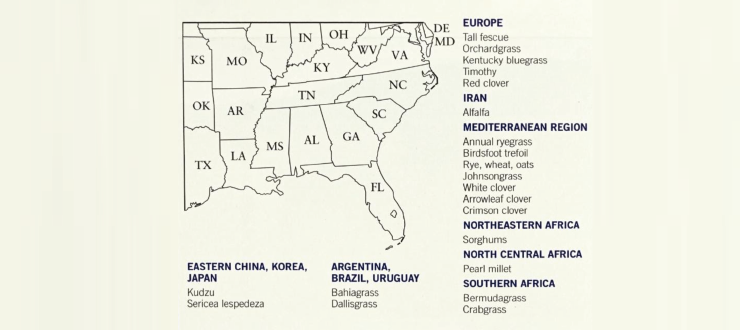
Have you ever wondered about where various forage crops we use originated? You may have assumed that most of them are native species, perhaps improved by plant breeders in some cases; you may have thought they mostly developed in various parts of the United States, or maybe you simply never thought about it.
In most of the eastern United States (east Texas to the Atlantic and from Florida to well north of Kentucky) there are only are a handful of native species that are planted and grown for forage, and even these are not widely planted. However, more than 40 forage species regularly grown in this area originated in other parts of the world.
There is a story, sometimes quite colorful and interesting, behind each forage crop we use. Through the use of a wide array of modern, sophisticated techniques, scientists have been able to obtain strong evidence as to where various crops developed and/or were first domesticated and used by humans.
Let’s begin with the warm-season perennial grasses. Bahiagrass is believed to have originated in the vicinity of southern Brazil and northern Argentina. Dallisgrass, a close relative of bahiagrass, is thought to have come from the same area. Our other two main summer perennial grasses, johnsongrass, and bermudagrass, are natives of Africa.
The cool-season perennial grasses we commonly use comprise a short list. Tall fescue is a native of Europe, probably coming from where Poland is now located. Interestingly, tall fescue is grown very little in Europe, although a closely-related plant, meadow fescue, is widely used there. Our most widely-grown variety of tall fescue, ‘Kentucky 31,’ came from an ecotype that developed on a mountainside in eastern Kentucky, but the original source of that patch of grass is also believed to have been Europe.
Kentucky bluegrass sometimes sparsely volunteers in some pastures in the Deep South but is a dominant species in some areas farther north, or at high elevations. It is thought to have come from the area where Hungary is not located. Orchardgrass, our only other cool-season perennial forage grass, also originated in Europe, probably in what is now Germany.
The cool-season annual species rye wheat, barley, and oats are highly important because of their usefulness as both grain crops and forage crops. These are believed to have been some of the earliest crops humans learned to cultivate, and it is thought that all of them originated in the Middle East in what is now the countries of Iraq, Iran, and Turkey. Annual ryegrass, our other important cool-season annual grass, is almost certainly a native of what is now Italy.
Our important warm-season annual forages include pearl millet, an African plant that probably developed in the vicinity of what is now Sudan. Sorghum and sudangrass developed in the Savannah area of Africa. Corn, grown widely for silage and grain, is believed to have developed in the vicinity of southern Mexico or Guatemala.
Like the grasses, our legume species are also from a diversity of areas. Alfalfa probably developed in the vicinity of Iran. White clover is thought to have come originally from what is now Turkey. Both arrowleaf clover and crimson clover almost certainly originated in what is now Italy. Both sericea lespedeza and annual lespedeza are of oriental origin, probably Japan.
Our commonly-used forage crops are important, useful, and quite diverse. Perhaps it is highly appropriate that they are like our American human population; a mixture of individuals with distinct and widely varying backgrounds.
Foraging Ahead is a column presented by Ragan & Massey and written by Dr. Don Ball, Professor Emeritus at Auburn University. Dr. Ball is one of the authors of the popular book “Southern Forages,” which can be found via a computer search that uses the words, “Southern Forages, The Fertilizer Institute
